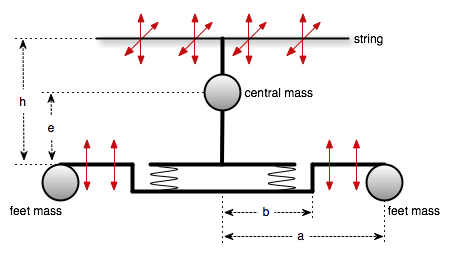Violin Bridge
Description
A basic violin bridge model.

Syntax and Default Values
A Violin Bridge can be created using the following Mlys (Max), mlys.lua, or Lisp syntax:
In Modalys for Max, this object is named mlys.violin-bridge:
TODO
(make-object 'violin-bridge
(central-mass .00177)
(feet-mass .00038)
(e-distance .013)
(a-distance .01625)
(h-distance .021)
(b-distance .0065)
(stiffness 1300000)
(freq-loss 10)
(const-loss 10))
modalys.make_object{ kind="violin-bridge", name="MyViolinBridge",
centralmass=0.00177, feetmass=0.00038,
edistance=.013, adistance=.01625, hdistance=.021, bdistance=.0065,
stiffness=1300000, freqloss=10, constloss=10 }
Parameters
All physical parameters can be numerical values or controllers.
- central-mass: central mass of the bridge in kg.
- feet-mass: masses at the base/feet of the bridge in kg.
- e-distance: distance from the central mass to the feet masses in meters.
- h-distance: distance from the string to the feet masses in meters.
- a-distance: distance from the center mass to the edge at the feet in meters.
- b-distance: distance from the center to the interior of the feet in meters.
- stiffness: stiffness of the spring between central mass and feet.
- freq-loss, const-loss: loss coefficients. See General object information.
The violin bridge has two axis of possible motion, both of which are linked to the stiffness value: it can compress (i.e., the central mass becomes in effect closer to the feet- masses), and it can rotate from side to side (at right angle with the strings). The bridge does not, however, move forwards and backwards (i.e., longitudinally with the strings).
Accesses
To access the feet of a violin bridge (to adhere it to an instrument body, or make an output on it, for example), the special access type 'base is used. -1 refers to the left foot, and 1 refers to the right. (A number in between will specify an access somewhere in the middle.)
(make-access my-violin-bridge (const -1) 'base) ;;; left foot
(make-access my-violin-bridge (const 1) 'base) ;;; right foot
(make-access my-violin-bridge (const <value>) 'top-horizontal)
(make-access my-violin-bridge (const <value>) 'top-vertical)
★